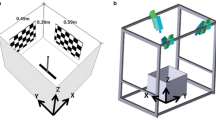Abstract
Optomotor responses of freely flying hawk moths, Macroglossum stellatarum, were characterized while the animals were hovering in front of and feeding on a dummy flower. Compensatory translational and rotational movements of the hawk moth were elicited by vertical grating patterns moving horizontally, mimicking imposed rotational and translational displacements of the animal in the horizontal plane. Oscillatory translational and rotational pattern motion leads to compensatory responses that peak in the frequency range between 2 Hz and 4 Hz. The control systems mediating the translational and rotational components of the optomotor response do not seem to influence each other. The system mediating translational responses is more sensitive in the fronto-lateral part of the visual field than in the lateral part; the opposite is true for the rotational system. The sensitivity of the translational system does not change along the vertical, whereas the rotational system is much more sensitive to motion in the dorsal than in the ventral part of the visual field. These sensitivity gradients may reflect an adaptation to the specific requirements of position stabilization in front of flowers during feeding.
Similar content being viewed by others
Author information
Authors and Affiliations
Additional information
Accepted: 13 August 1997
Rights and permissions
About this article
Cite this article
Kern, R., Varjú, D. Visual position stabilization in the hummingbird hawk moth, Macroglossum stellatarum L. I. Behavioural analysis. J Comp Physiol A 182, 225–237 (1998). https://doi.org/10.1007/s003590050173
Issue Date:
DOI: https://doi.org/10.1007/s003590050173




